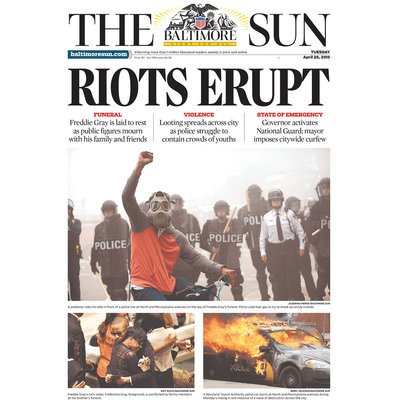The 2015 Baltimore Riots: A Teachable Moment
The Newseum believes that improving civic education has the power to improve our schools, communities and our democracy. The Baltimore unrest can be an entry point in your conversation with students.

We’ve all seen the disturbing images out of Baltimore: Stores looted. Buildings and cars set ablaze. Crowds clashing with riot-gear-clad police officers.
On Tuesday, a day after the mayhem, the city was essentially shuttered. A curfew was in place, and schools canceled classes. Amid the unease over whether violence would flare up again was a larger discussion – a self examination, of sorts – over causes of the unrest and the media’s coverage.
The Newseum has numerous resources to help teachers broach this topic in the classroom. Lesson plans, videos and activities guide students in how civil rights issues have been represented in the media over many decades. And how citizens, including young people, can develop a voice and use the freedoms of the First Amendment to effect change and inspire action.
Baltimore was just the latest public outcry over police treatment of African Americans. Before that, it was killings by police of unarmed blacks in Ferguson, Mo., North Charleston, S.C, New York City, and elsewhere.
Monday’s violence followed the funeral of a 25-year-old black man who died of a spinal injury while in police custody. President Obama, while condemning the behavior of “criminals and thugs” in Baltimore, described tensions between the African-American community and some law enforcement as a "slow-rolling crisis.” “This has been going on for a long time,” he said. “This is not new, and we shouldn't pretend it's new."
NewseumED's Making a Change EDCollection provides educators with that historical connection. A timeline – packed with text and historic videos, photos, and front pages – captures that sense of hopelessness and pent-up anger prevalent during the American civil rights movement. It gives students a “who, what, when, where and how” of the era and allows them to make comparisons between then and what is happening now. (NewseumED is free, but you must be registered to access it.) For example, a scuffle by white patrolmen with a black motorist suspected of drunken driving triggered six days of rioting by blacks in Los Angeles in 1965. Thirty-four people died, thousands were arrested and property damage exceeded $40 million. The National Guard was called in to help quell the violence.
Martin Luther King Jr. drew the nation’s attention to the underlying causes behind the Watts riot, noting they were “environmental and not racial. The economic deprivation, social isolation, inadequate housing and general despair of thousands of Negroes teeming in Northern and Western ghettos are the ready seeds which give birth to tragic expressions of violence.” There’s a video online of the Watts riot that can be used to analyze the tone of the coverage.
A Media Literacy lesson plan also helps students understand the purpose and components of a news report, and to decide if stories meet journalistic standards of being accurate, fair and clear. Your students could use the same worksheet to analyze coverage of the Baltimore turmoil. Did photo selection, word choice in headlines and stories, amount of time or space devoted follow best practices? And, contrary to some people’s beliefs that only blacks riot, you will find examples in the Making a Change unit of whites turning to violence. One example is the East St. Louis riots in 1917, in which whites, fearing that their jobs could be at risk, beat and killed black workers and set their property on fire. Another example is the violent protest that erupted when James Meredith, a black, attempted to integrate the University of Mississippi.
The unit focuses on much more than just civil unrest. It examines how First Amendment freedoms can be used to bring about positive change. There are numerous examples of young people who used non-violent means in their push to end discrimination and get a Voting Rights Act passed. Let your students discover some of those unsung participants, such as the Freedom Riders or the Farmville (Va.) students who went on strike, and lead them in a conversation about civic engagement. The adaptable, standards-based lesson plans in the Making a Change EDCollection focus on three areas: Historical Connections, Media Literacy, and Civics and Citizenship. The civics lessons make a connection between the historic achievements of the civil rights movement and today’s struggles to improve communities. Students focus on an issue in their own community and lay the foundation for further exploration and action.